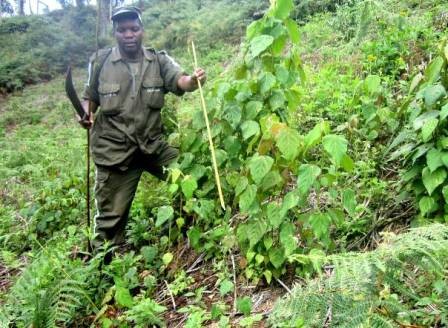
New, wild forest seedlings are finally seeing the light again in Rwanda's Nyungwe National Park. They are slowly taking back areas previously covered with a layer of opportunistic ferns. After a wildfire, the forest soil is quickly colonized by a thick, persistent layer of ferns, which thrive in disturbed areas. The ferns dominate, impeding the ability of other wild species to germinate.
Forest fires are a major threat to the park. In 2004, researchers estimated that approximately 12 percent of the total forest surface was affected by wildfires from the late 1990s. The majority of fires originated from human activities and most were caused by people harvesting honey inside the park, which involves smoking bees out of their hives. In recent years, such activities have caused fewer, and smaller, fires due to more effective and widespread monitoring by park guards.
Fern colonization is long lasting: Most of the forest affected by 1997 fires is still completely covered by ferns. The areas colonized by ferns have very little value as wildlife habitat, thus reducing the already limited resources available.
To counter these effects, USAID supports the Wildlife Conservation Society in regeneration efforts, including cutting ferns in targeted plots and maintaining the plots fern-free until new forest seedlings succeed in emerging from the ground.
The work isn’t easy. The ferns establish themselves as a thick blanket covering the ground, and eradicating them is a hard, painstaking job. It requires slow machete-cutting at the base of the ferns until reaching the ground. The job must be repeated over the course of three years before the forest will start growing back.
Despite the challenges, the rewards can actually be seen and touched. As of mid-2013, 33 plots totalling 9 hectares have been cleared. “Just one year after the first fern cutting, I am finding new, wild forest seedlings emerging for the first time in over 15 years,” reports Bosco Mureritesi, WCS field botanist. He has cared for the new forest seedlings in the regenerated plots.
For the first time in years, bush pigs and small forest antelopes are returning to roam and forage in areas that have been cleared from ferns. These animals will continue playing their key ecological role of dispersing seeds and facilitating regeneration, and the forest around them will grow in value and keep attracting tourism, generating important income for the surrounding populations: all good signs of a new future for Nyungwe.
These efforts are part of USAID's five-year project, which ends in 2015, to sustain biodiversity in and around Nyungwe National Park. The project seeks to protect the park's wildlife and natural resources by reducing threats such as fire, poaching and timber harvesting through community education, improved ranger monitoring systems, and sustainable alternatives to natural resource use for surrounding communities.







Comment
Make a general inquiry or suggest an improvement.